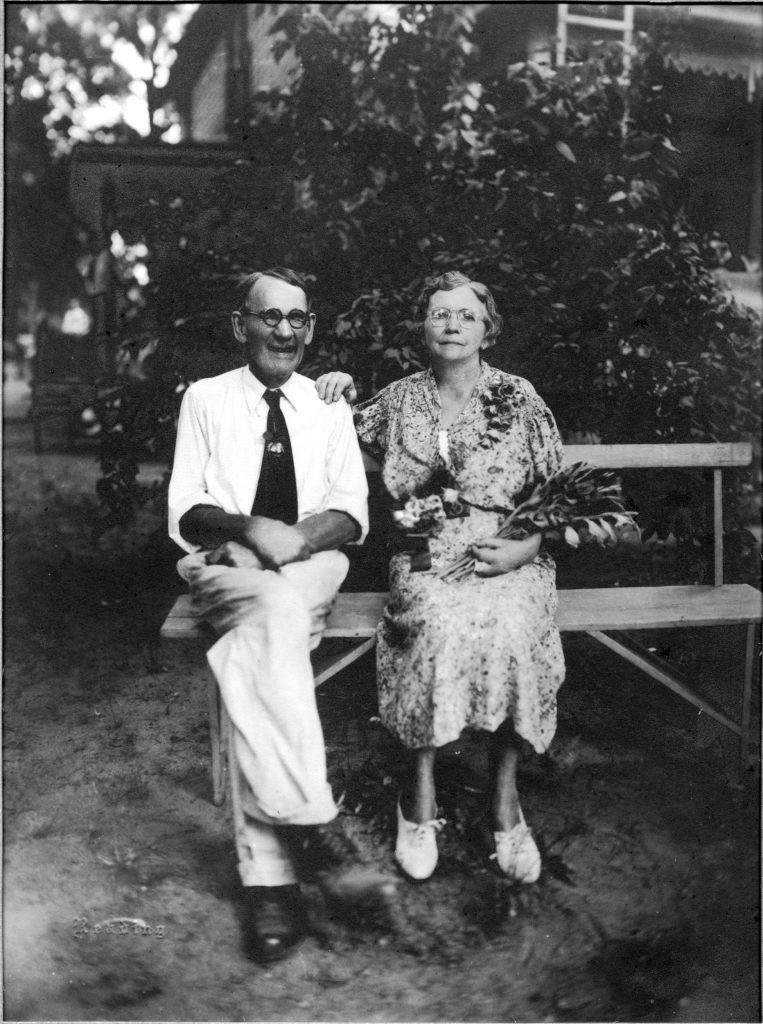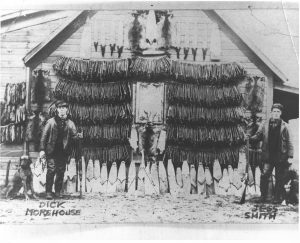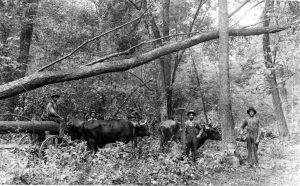Siftings
The story of Rowley Morehouse
October 24, 1934
There’s a story of Rowley Morehouse, one of the most picturesque men of the river country, and a man who’s lived there for 52 years. Says Mr. Morehouse:
I have lived in one place for 50 years. I am now living in the third house on the same farm. The old houses are now used for storage purposes. In other words my wife and I have worn out two houses. About 50 years ago, when I lived in northern Michigan, two men told me of having been down on the Kankakee, rafting logs along the banks of a place called “The Oxbow.” I was a boy then, and afterwards, in 1884, I bought” Oxbow later I bought Carson Bayou, and became the possessor of two of the most notable places on the river. They were the great duck homes for the reason that lots of oak grew there, and they came in to get the acorns.”
The Kankakee River at times was 35 miles wide from the Oxbow to the Nickel Plate Railroad up near valparaiso and 15 miles on the other side. Then west of here 20 miles it gets even wider and so on until you get to the state line. Then it became just a river running between the two high banks. It starts as a brook, just a small stream up at Studebaker’s, near South Bend and I have traveled every mile of it. The biggest mistake ever made by the government was when they reclaimed the Kankakee, as it was known all over four states be one of the greatest duck haunts of those states. I was told by a millionaire who had hunted all over the world-even hunted the Buffalo on the prairies, where he sometimes got only one shot in a month, of how he liked the Kankakee, because when he went out in the river he never went with less than a hundred shells, and was able to burn them in a day’s shoot. When my brother and I were young, the young men of the neighborhood used to come to our house in the evening to see what we caught that day. One incident I remember very well. At breakfast it was mentioned where we’re going. The man said he was going east, and I said I would go west. We had six hunting dogs, but we never used all of them at the same time, as they got so tired. The man took a good dog for Coon, and I took one for mink. When he came in that night he and nine coon and I had one mink and nine coon. I caught six coon and not another one day hunt. Another time I got two otter in one day, and if I didn’t get half a dozen mink or coon in one day I didn’t consider it a normal day at all. My brother and I caught 72 prairie wolves in my experience on the Kankakee River of about 35 years of hunting, and we have got 75 muskrat in one night, and three or four coon. We killed numberless ducks and geese here. My brother and I and two or three other hunters got 225 docs and 21 geese in three days. Mr. C. J. Kern was one of those hunters. He loaded those ducks and geese in his buggy, tieing them all over when he couldn’t load any more in it and started home to Valparaiso. It froze that night pretty solid, and when he was gone about one half a mile and axel sprung down and the wheels came against the box of the buggy. He came back to my place, so I had to take those ducks and geese to Valpo with a wagon and team. He drove ahead in his buggy and the next day when I drove up to his story he came out in a shirtsleeves and threw those ducks and geese out of the wagon as if they were pumpkins, and there they lay on the sidewalks in a big pile.
Of the old hunters of 52 years ago, only 10 or now alive to the best of my memory. Three live in Jasper County and are my neighbors, and seven are in Porter County. They are Link Arnold, Porter Childers, Johnny Benkie, George Runyan, Hank Haring and Joe Leiser. That’s all that’s left of over 200 that I used to meet frequently. Why I go on and indefinitely and tell you one incident after another of my hunting experiences-enough to fill a book and all true. There is no need to exaggerate any because it was a wonderful place for all sorts of game and God’s plenty of it. Why I haven’t a hat out here in my place that is 43 years old. I bought it of J. Lowenstine in his store in Valparaiso, and it’s a purty good old hat yet.
I want to take exceptions to the statement made by one of the speakers here tonight. He said that this region was made up of sand wastes, unfit for farming purposes. On the contrary, this land is very fertile, and capable of raising 80 bushels of corn, 80 bushels of oats, 42 bushels of wheat to the acre and other crops in proportion. The soil contains ample phosphates and phosphorus and nitrogen, lacking only potash. Fertilizers furnish the potash, and now that I can get it made in this country it will be cheaper than the German product.
Fifty-two years ago I started to acquire land for a farm in this section. I bought all I could pay for, and since then have managed to get title to and now own 1000 acres of land in sections 1, 35 and 36 in Winfield Township, Jasper County. About 700 acres of this land is now under cultivation. The rest of it is marshlands and former hunting grounds. Part of it is Oxbow, and Cuson Bayou. In 1895 Nelson Morris began buying up tracts of land in the river region, and with his coming prices jumped from $12 an acre to as high as $175 an acre. Morris once announced that he would buy the whole county of Jasper if they would abolish the courthouse. He used these lands for cattle grazing, and at one time head as high as 8000 cattle on his marshes in this county. He provided a good market for all the available wild hay that could be cut. I sold him in one year about 1000 tons of this a cut from my lands. Of course the annual rise in prices of agricultural products created by the world war sent land prices sky high and far beyond their real values, and many who rushed in and bought these lands of the land companies paid more than they could earn under normal conditions. Many of these people lost their farms through the changes in prices that follow. It was not the fault of country or the land. It was a case of basing values on abnormal earnings.
Personally, I think it was a bad mistake to straighten the Kankakee River. Before this was done this region was the greatest hunting ground in the five states around us. Man can never bring back the river to its original state. Even the spending of three or five million dollars would not do it now. In order to get anywhere they would have to take a strip of land all the way from 25 to 35 miles wide. I believe it would be a great mistake to try to restore the river by buying an 8 mile strip. I will tell you why. I will take Porter Childers, George Runyan, Fred Rosenbaum, George Bancroft, William Morrehouse and myself, and in two days we would shoot all the ducks out and they would never return again. In the old days when the river and its marshes were from 25 to 35 miles wide, and when the shooting became too heavy for the ducks they had a chance to fly off 10 to 15 miles, and find a place where they would not be molested for a week. Wild fowl must have lots of room to range in, and no 8-mile strip will do. Shoot at a bird in one piece of water and he will never come back to that spot again.
Going back to incidents that I remember, I recall my acquaintance with General Lew Wallace, one of the greatest men I ever knew. I could talk about him for days. He was a great lover of the Kankakee. I have talked with him on many occasions, and he has been my guest in my home many times. He seemed to take my stories and often urged me to tell them. At one point not more than 80 rods from Oxbow Bend he wrote 13 chapters of his famous story, “Ben Hur.” General Wallace met my brother and what is called duck pond. He was eating dinner on an island. He saw my brother slaughtering the geese while out in the sink tub. My brother had then killed 31 geese. General Wallace took his pusher to go out and hire the tub for the afternoon, which he did. Mr. Wall’s one-out in that afternoon and killed geese. He paid $10 for the use of the tub, and said that money could not buy them. He had killed them himself.
General Wallace one day was on a piece of land four miles west of Baum’s Bridge and 2 miles south. There he was so taken up with the game that was there that he said he was going to buy that section if it could be bought. Two weeks later he was the owner of that section of 640 acres. This track was the home of General Wallace for many years. After his death George Wilcox was its custodian, and after Wilcox died the heirs took its management over. General Wallace build a house on this land which he used while he spent his hunting vacation here, after that.
Clem Kern, of Valparaiso also was a great lover of this region. After he was elected to the legislature and went to Indianapolis he fell in with another member, Mr. Jent, from Crawfordsville. The two became great cronies. Jant was a man of but few words, and never made a speech but once while he was a member, and that was when a bill came up affecting the privileges of sportsmen. But Kern was the opposite and loved to talk.
Jent sat right behind Kern, and when he got up to make a speech, Jent would say: “Give ‘em hell, Clem.” And then go off to sleep. Jent got to coming to the Kankakee River and made his headquarters at the home of Albert Featherlan. Jent was so pleased with his quarters and his host that one day he said: “Albert, I want you to go to Valparaiso, get an architect, a contractor, and material for a nice brick house, which I want you to build right here on this slope, where I can see the ducks and geese come in. And I want you to build that house two stories with basement, so I can sit in that basement and see the wild fowl show. Just charge the bill to me.”
The house was built according to Jent’s instruction and that game old sportsmen did foot the bill. In this home the old man came every hunting season until he passed away. That man had been a hunter of big game, and hunted not only in the best hunting grounds of his own land but also in the being key big game regions of the world. He said:” I like this region best. Out west I may get a shot in a week, but here I can shoot to my hearts content and get something every time I take aim.”
Clem Kern was a man who, if he was your friend, would go far to help you. One day I told him out like to buy a small track of timber that I thought I could make some money with. The price was $500, a sum I did not have at the time. It is not long afterward when Clem came to my house and threw a deed into my lamp, saying, “There is your timber title. I got the abstract examined and it is okay.” I sold the timber for the cost of the land some time afterward, and one day a year or so afterward when Kern came down to shoot ducks I hand him thirty twenty-dollar gold pieces. He said: “What am I going to do with that stuff?” I got him a couple of shot bags and put the money in. And that was the end of that. That was the kind of pal Clem Kern was to me.”





